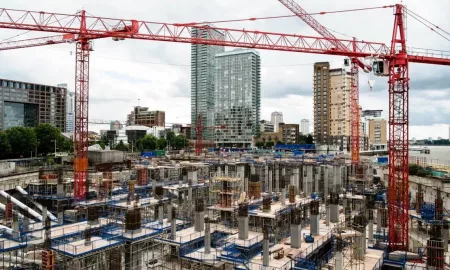If you’re new to geotechnical and structural monitoring, are looking to procure these services for the first time or just want to refresh your memory of some of the key terms, this A to Z will help you understand everything from ‘asset monitoring’ to the ‘zone of influence’.

If you’re new to geotechnical and structural monitoring, are looking to procure these services for the first time or just want to refresh your memory of some of the key terms, this A to Z will help you understand everything from ‘asset monitoring’ to the ‘zone of influence’.
Asset Monitoring
Asset monitoring provides critical intelligence about an asset’s condition throughout its lifecycle, supporting and informing decision making surrounding its operation and maintenance.
Much of the UK’s infrastructure assets are ageing, this includes structures such as bridges, tunnels and buildings; transport networks such as rail, highways, canals, rivers and ports; utilities and dams. These deteriorating assets require investment in maintenance to ensure that they continue to perform at optimal levels, allowing the continued safe use of these assets while simultaneously delivering value for the asset owners.
Asset Fit is SOCOTEC Monitoring’s remote asset monitoring solution, created for managers of assets, resulting in a reduction of on-site monitoring visits, real-time data provision and a clearer view of the lifespan of the asset.
Bearing Capacity
The safe bearing capacity of a soil is the maximum value of contact pressure to which the soil can be subjected without risk of shear failure. This is based solely on the strength of the soil and is simply the ultimate bearing capacity divided by a suitable factor of safety.
C701 Crossrail
At the time of construction, the Crossrail project was the biggest tunnelling project in Europe, with around 21km of the total 118km route contained within newly bored tunnels. SOCOTEC Monitoring was contracted to provide monitoring systems for the various third party assets within the central section of the route. At the time, this was widely regarded as the largest monitoring contract ever awarded, and SOCOTEC Monitoring installed and maintained over 30,000 sensors across 15 separate sites in central London.
Deformation Monitoring
Deformation refers to the change in size or shape of an object. Monitoring the effects on existing structures during new construction projects, as well as those concerned with natural forces, has traditionally been carried out using devices such as strain gauges and inclinometers. For example, during the Soho Place development works, SOCOTEC Monitoring provided extensive monitoring systems to measure the impact on above ground assets during the demolition phase, and continues to monitor a range of London Underground and Crossrail assets as construction progresses. To allow monitoring for deformation of the pile walls during excavation of the basements and construction of the sub structures, inclinometers were installed within the piles for the Over Station Development, and strain gauges installed to temporary props.
Embankment
An embankment usually refers to a built-up volume of earthen material that is placed and compacted for the purpose of raising the grade of a roadway, railway or dam above the level of the existing surrounding ground surface.
Monitoring embankments is a common requirement, and SOCOTEC Monitoring has vast experience in this area, for example:
- monitoring the impact of excavation and construction works on an adjacent embankment and section of track during the Shuttleworth Road Development
- monitoring embankment stability and Network Rail assets during the Newhaven Port Access Road project
- providing monitoring equipment and services to assess construction progress and confirm the settlement and slope stability before, during and after the A4440 Worcester Southern Link Road Widening Works to the existing embankment
Foundation
The part of a building or structure that transfers the loads from the structure to the underlying soils. Foundations are classified as shallow foundations (such as raft or strip) or deep foundations (such as pile). Each classification can pose different risks to underlying or adjacent assets. SOCOTEC has extensive experience in ground improvement and foundation monitoring schemes, providing a complete service from whole site monitoring to applicable test methods.
Geotechnical Engineering
Geotechnical engineering, also known as geotechnics, is the branch of civil engineering concerned with the engineering behaviour of earth materials. Geotechnical engineering uses principles of soil mechanics and rock mechanics to investigate subsurface conditions, determine the relevant physical/mechanical and chemical properties, design earthworks and structure foundations, and monitor site conditions. Covering the whole project lifecycle, SOCOTEC offers an integrated package of site investigation services to accurately investigate, test and advise on a range of geological and structural conditions.
Heave
Ground heave is the upward movement of the ground usually associated with the expansion of high plasticity clay soils. Heave is often encountered when stress conditions change, as with basement excavations, and /or when trees or certain vegetation are removed. The upward pressures can be high and lead to significant structural damage.
To help Transport for London (TfL) understand the behaviour of existing assets prior to commencement of intrusive works for the Silvertown Tunnel construction project, SOCOTEC Monitoring provided extensive baseline monitoring systems, including measuring heave and vertical settlement on the Southern Gas Networks and Birch Sites’ retaining wall assets.
Inclinometer
An inclinometer – also known as a tilt sensor or slope sensor – is an instrument used to measure angles of slope (or tilt), elevation, or depression of an object with respect to gravity's direction.
During the construction of a new Lidl food store on Richmond Road in Twickenham, strings of in-place inclinometers were installed at the gable end of an existing party wall to measure rotation. Another example of inclinometer use can be found in the Dover Western Docks Revival (DWDR) Marine Structures and Bridge contract case study, where in-place inclinometers were installed within the listed Prince of Wales Pier.
Joint Metre
A joint metre – also known as a crack metre – is a geotechnical instrument used to monitor displacement across surface cracks and joints in concrete, rock, soil and other structures.
Kinematic Envelope
When rail vehicles move along a track, they experience vertical and lateral movement, due to the effects of tilt, sway and cant. The outline of the space that trains occupy when in motion is known as the kinematic envelope. Track geometry and tunnel gauging surveys (Amberg Trolley) are undertaken to establish the tolerances in relation to the kinematic envelope.
Line and Level Correlation Survey
A line and level correlation survey uses land surveying techniques to accurately locate sub-surface infrastructure, such as tunnels and culverts. The survey data is often used by contractors designing deep foundations and by consultants undertaking Ground Movement Analysis (GMA).
Monitoring Synonyms
Depending on your work background and area of specialism, you may refer to geotechnical and structural monitoring as ‘monitoring,’ ‘surveying,’ ‘site monitoring,’ or even ‘testing’. It is always important to confirm what exactly is meant when those terms are used. At SOCOTEC Monitoring we have come across all of these variations, and more.
Noise Monitoring
When undertaking any kind of development works – whether that’s the construction of roads, bridges, buildings or other infrastructure – there is the potential impact on the surrounding environment or receptors to consider. Noise is one of the most common forms of pollution and, if left unmanaged, can severally disrupt or even delay a project. Environmental noise assessments and monitoring, including scenario modelling using specialist software, has become an essential component of any demolition and construction project. SOCOTEC’s Environmental Monitoring team is highly experienced in supporting a wide range of sectors with environmental noise assessment and control, using the latest instrumentation to accurately monitor noise levels.
Optics
Used to measure strains in structures and geotechnical processes, fibre optic technology uses light - rather than electric current - as the signal carrier. Used to monitor the structural health of tunnels, excavations and piles, fibre optic sensing is an innovative, reliable and cost-effective method of monitoring.
PRIME
PRIME™ is the low-cost, innovative new earthworks monitoring technology developed by The British Geological Survey (BGS). Building on non-invasive Electrical Resistivity Tomography (ERT) - a geophysical imaging technique that is sensitive to compositional variations in the subsurface as well as changes in groundwater saturation and the presence of contaminants - PRIME™ technology enables asset owners to 'see inside' vulnerable earthworks such as dams, and delivers automated updates on condition changes providing early warnings of asset deterioration.
Quick Dynamic Sampling
Quick Dynamic Sampling is used for high frequency monitoring and allows engineers to monitor sensors up to 333 times a second.
Robotic Total Station
A Robotic Total Station (RTS) is a total station that can be operated remotely. Used in surveying and building construction, a total station is an electronic, optical instrument that measures both vertical and horizontal angles and the distance from the instrument to a particular point. A Robotic Total Station is often used for the monitoring of ground or structural movement over very extended periods of time and can achieve reading accuracies of +/-0.6mm for distance and 0.5 seconds for angles to geodetic prisms.
Settlement
Settlement refers to the downward movement of soil or a structure and often results due to an increase in imposed loads or due to inundation of water.
Topographical Survey
Also known as land surveys, topographic surveys are detailed and accurate plan drawings which identify both man-made features - such as buildings, infrastructure and fences - and natural features – such as trees and streams - within a specified area. The elevation of the terrain is also detailed using land contours and spot levels. SOCOTEC has the skillset and expertise to undertake topographic surveys to the highest level of precision, assisting clients in the early planning and design stages of a project.
Understanding Assets
Using a combination of state-of-the-art technologies – including wireless, remote monitoring – SOCOTEC Monitoring’s systems help asset owners better understand their asset’s behaviour, delivering critical intelligence about an asset’s condition and its environment throughout its lifecycle which could save money on future remediation requirements.
Visualisation of Data
Supporting vital decision making, visualisation of your monitoring data improves the overall effectiveness of any construction or asset monitoring project. Providing instant and reliable access to your data, and designed to offer a user-friendly graphical interface, Calyx allows quick and easy visualisation and interpretation of large amounts of validated instrumentation data from multiple sources, regardless of project scale.
Waterloo International Terminal Development
London Waterloo is the busiest railway station in the UK, serving approximately 100 million passenger journeys annually, and this is set to increase. Network rail is aiming to increase the station’s capacity by 30% by reintegrating the disused international terminal into the rest of Waterloo Station, bringing five former Eurostar platforms back into use for commuter trains and providing additional rail capacity for passengers.
SOCOTEC Monitoring has been contracted by ISG to carry out monitoring and surveying works during the remodelling of Waterloo’s International Terminal as part of the wider Waterloo Retail Scheme being developed by regeneration specialists LCR.
X-Axis
The ‘principal’ or horizontal axis of a system of coordinates, points along which have a value of zero for all other coordinates.
Y-Axis
The vertical axis is called the y-axis. The point where the x-axis and y-axis intersect is called the origin.
Zone of Influence
The identified area that will be affected by the activity, whether that’s demolition, excavation or construction works. Often referred to in relation to rail and utility infrastructure.
If you have a geotechnical or structural monitoring project to discuss, or any terms which you’d like clarifying, please get in touch.
Want to find out more about SOCOTEC's asset monitoring services?

You might also like







Add new comment